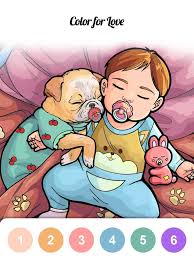Calm Color Coloring games
In a world where stress and overstimulation are commonplace, Calm Color coloring games offer a serene escape through the timeless act of coloring. These digital coloring apps, available on platforms like iOS, Android, and web browsers, blend relaxation with creativity, appealing to players of all ages. By transforming the tactile joy of coloring books into an interactive, accessible format, Calm Color games have carved a niche in the casual gaming landscape. This article explores the origins, mechanics, appeal, therapeutic benefits, and cultural impact of these games, highlighting why they’ve become a go-to for mindful entertainment.

Origins and Evolution
The concept of coloring games draws inspiration from traditional coloring books, which have long been used for relaxation and self-expression. The digital shift began in the early 2010s with the rise of mobile gaming, as developers saw potential in replicating the calming effects of coloring on smartphones and tablets. Titles like Calm Colors: Coloring Book (available on the App Store) and Colorfy emerged, offering vast libraries of digital illustrations and intuitive tools. These games evolved from simple pixel-based apps to sophisticated platforms with high-quality designs, gradient tools, and social sharing features.
Calm Color games, in particular, gained traction for their focus on stress relief and mindfulness. Inspired by the adult coloring book trend of the mid-2010s, developers like Happy Color and Lake emphasized therapeutic gameplay, incorporating soothing music and minimalist interfaces. The genre has since expanded to include themed templates—from mandalas to nature scenes—and augmented reality features, ensuring broad appeal across demographics. Today, Calm Color apps like Color by Number and Zen Color dominate app stores, reflecting their enduring popularity.
Gameplay Mechanics
Calm Color coloring games are designed for simplicity and accessibility. Players select from a gallery of black-and-white illustrations, ranging from intricate mandalas to cartoon characters or realistic landscapes. Using a digital palette, they tap or swipe to fill outlined sections with colors. Many games use a color-by-number system, where each section is marked with a number corresponding to a specific shade, making it beginner-friendly. Advanced apps, like Lake, offer freeform coloring, allowing users to choose colors freely or use gradient brushes for nuanced effects.
The mechanics are intuitive: tap to fill, pinch to zoom, and swipe to navigate. Toolsets often include brushes, fill buckets, and erasers, with premium versions unlocking special effects like glitter or watercolor textures. Games like Happy Color provide daily new templates, keeping content fresh. Some apps integrate progression systems, rewarding players with coins or achievements for completing artworks, while others, like Zen Color, focus purely on relaxation without gamified pressure.
Accessibility features enhance the experience, with adjustable color palettes for colorblind users and scalable interfaces for all devices. Offline modes ensure playability anywhere, while cloud syncing lets users save progress across platforms. The lack of time limits or failure states makes these games a low-stress activity, ideal for unwinding.
Why They Captivate
Calm Color coloring games thrive on their ability to evoke tranquility and creativity. The act of coloring, even digitally, taps into a meditative state, encouraging mindfulness by focusing attention on the present moment. The color-by-number format provides structure, appealing to those seeking guidance, while freeform modes cater to artistic expression. This duality ensures broad appeal, from children learning colors to adults seeking stress relief.
The visual feedback—watching a blank canvas transform into a vibrant artwork—delivers instant gratification. Soothing soundtracks, like ambient nature sounds or soft piano, enhance the calming experience, as seen in Zen Color. The games’ portability makes them perfect for quick breaks, whether during a commute or before bed. Social features, such as sharing completed artworks on platforms like Instagram, foster a sense of community and pride.
Replayability is another strength. With thousands of templates—from animals to fantasy scenes—and regular updates, players rarely run out of content. Games like Color Therapy encourage personalization, letting users import photos to create custom designs. This blend of structure and freedom keeps players engaged, whether they play for five minutes or an hour.
Therapeutic and Educational Benefits
Calm Color games are widely recognized for their therapeutic benefits. Research, including studies from the American Art Therapy Association, suggests that coloring reduces stress and anxiety by engaging the brain’s reward centers and lowering cortisol levels. The repetitive, focused nature of coloring promotes mindfulness, helping players manage racing thoughts. Apps like Lake are designed with mental wellness in mind, offering curated calm-inducing palettes and minimalist interfaces.
For children, coloring games teach color recognition, fine motor skills, and number sequencing through color-by-number mechanics. They also foster patience and focus, as completing intricate designs requires sustained attention. In educational settings, teachers use apps like Coloring Book for Kids to engage young learners, while parents value the screen-time alternative that feels productive.
Adults benefit from cognitive maintenance, as coloring stimulates visual processing and spatial awareness. For seniors, Calm Color games can support mental agility and provide a low-pressure creative outlet. Therapists sometimes recommend these games for clients with anxiety disorders or ADHD, as the structured yet flexible gameplay helps regulate emotions.
Cultural Impact and Community
Calm Color coloring games have built a vibrant community, particularly on platforms like Pinterest and Instagram, where players share their completed artworks. Hashtags like #HappyColor or #ColorByNumber showcase stunning creations, from mandala designs to pop culture icons. Online forums, such as Reddit’s r/Coloring, discuss favorite apps and techniques, fostering a sense of connection.
The games’ cultural footprint extends to mental health advocacy. Brands like Lake partner with artists to promote wellness, with proceeds supporting creative communities. Schools and libraries use coloring apps in mindfulness workshops, while posts on X highlight their role in stress management during high-pressure times, like exam seasons. The genre’s accessibility—many apps are free with optional in-app purchases—ensures inclusivity, though some players note ad-heavy free versions can disrupt the calm experience.

Conclusion
Calm Color coloring games offer a digital sanctuary, blending creativity, relaxation, and accessibility into a universally appealing package. Their therapeutic benefits, from stress relief to cognitive development, make them more than just games—they’re tools for wellness and self-expression. Whether you’re a child exploring colors, an adult unwinding after work, or a senior seeking mental stimulation, these games provide a soothing escape. As developers continue to innovate with new templates and interactive features, Calm Color games will remain a vibrant canvas for creativity and calm in a hectic world.
